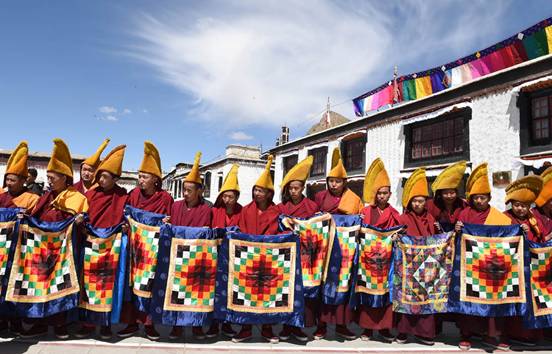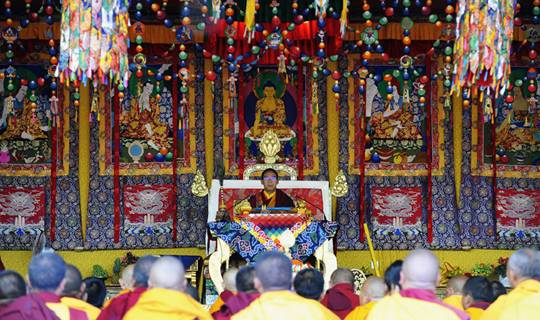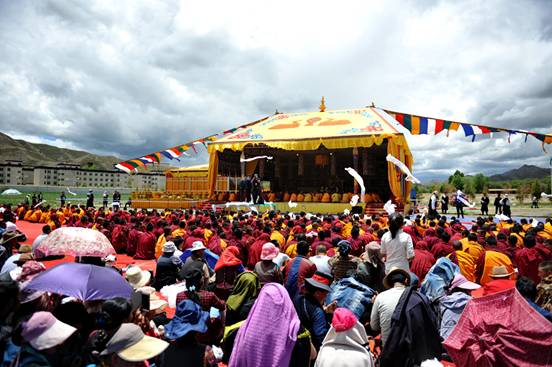Patriotism of the Panchen Lamas
The Tashi Lhunpo Monastery has always been a holy place for worshippers near and far. It is one of the six major temples in the Gelug sect of Tibetan Buddhism and the official residence for generations of Panchen Lamas. The monastery enjoys year-round visits from a steady stream of worshippers.

Photo taken on May 27th shows the monks of Tashi Lhunpo Monastery welcome the 11th Panchen Lama.
Tashi Lhunpo Monastery means a monastery where harmony reigns. Founded in 1447, the monastery has more than one thousand Buddhist palaces, prayer halls, pagodas, and monks’ residences throughout the mountain.
Champa Hall in the monastery was built in 1914, honoring the 26-meter tall Champa Buddha, which is the largest gold-plated bronze statue of a Buddha in the world. After climbing more than 100 steps up to the temple, one will be able admire the grand statue, where the non-stop worshippers and tourists rub shoulders inside the busy hall.
After leaving the Champa Hall, onecan follow a smooth wooden staircase into the Han Buddha Hall where the Qing Dynasty emperor is honored. In 1713, when Emperor Kangxi of the Qing Dynasty decreed the 5thPanchen Lama the “Panchen Erdeni,” he also ensealed the Panchen Lama’s previous incarnation.
Dondup Cheng Lama has been a monk at Tashi Lhunpo Monastery for more than 20 years. He knows every palace and prayer hall here by heart. The monastery has a memorial palace for the 4thPanchen Lama, a joint memorial palace for the 5th to9th Panchen Lamas, a memorial palace for the 10th Panchen Lama, and other important halls.
Every day, many believers and tourists would pay visits to theholy places. Asthe tour guide for the day, Dondup Cheng Lama would always talk to the guests about the patriotism and faith of the Panchen Lamas throughout the ages, and their honorable tradition of protecting the country and the people.
The War of Resistance Against Japan, which began in 1937, had the participation of many Tibetan Buddhism visionaries, which was represented by the 9thPanchen Lama. They devoted themselves to the cause, made vital contributions toward the war victory against the Japanese aggression.
Inside the palace for the 10th Panchen Lama, Dondup Cheng closed his hands in prayer and said to the Panchen Lama’s portrait, “The memorial pagodas for the 4thand 5thto 9thPanchen Lamas were all made of silver, only the 10thPanchen Lama’s memorial pagoda was sculpted in gold. This shows the Party and the country’s affirmation for the Panchen Lama’s patriotism and faith.”
In 1993, the 10thPanchen Lama’s pagoda and palace was officially unveiled. The central government used 614 kgof gold, 275 kgof silver, and over 200 gems in the construction, investing over 64 million yuan to build the grand hall of cultural artifacts and artistic heritage.
In the 1950s, the 10thPanchen Lama’s firm support for Tibet’s peaceful liberation and steadfast support for democratic reform has helped guide the adjustment of Tibetan Buddhism with a socialist society. The Panchen Lama worked tirelessly to better the lives of the people, and enjoys reverence from the believers.

Photo taken on July 4th shows the 11th Panchen Lama Erdeni Choskyi Gyalpo conducts the initiation ceremony for worshippers.
According to monks, the 11th Panchen Lama is currently hosting various Buddhist events at the TashiLhunpo Monastery. The Panchen Lama has said at various events that he would always pass on and promote the honorable tradition of patriotism, remember his responsibility, and serve the believers.

Photo taken on July 4th shows the 11thPanchen Lama Erdeni Choskyi Gyalpo conducts the initiation ceremony for worshippers.
“The Party and the government have given us a lot of attention.” Said Adun, a 46-year-old monk. The monastery has complete health insurance coverage, senior benefits, and a basic living standard guarantee for everyone; there is water, electricity, internet service, TV, and reading rooms, as well as nursing home. The Tashi Lhunpo Monasterywas given the model temple award.
Since 2011, the Tibet Autonomous Region has innovated its temple management methods, aiming to improve the quality of the temples’ public services. Transportation, electricity, water, communication, radio and TV, are all made possible, solving the day-to-day living problems for the monks and nuns, and receiving their support in turn.
During the “2016 Forum on the Development of Tibet” on July 7th, Living Buddha Drukhang Thubten Khedrup, Director of the Tibet Association of the Buddhist Association of China said, “Now, the monks, nuns, and believers at the monasteries all enjoy the protection of national regulations and laws, and have complete freedom in practicing their religion. Tibetan Buddhism is in the best development period of its history.”
Your Comment
Name E-mailRelated News
-
;
-
-

-
Yu Zhengsheng visits Tashilumpo Monastery during Tibet tour
Yu Zhengsheng, chairman of the National Committee of the Chinese People's Political Consultative Conference, visits Tashilumpo Monastery during a tour to Xigaze, southwest China's Tibet Autonomous Region, Sept. 10, 2015
-
-
-

-
Tashilhunpo Monastery: holy monastery in earthliness
Tashilhunpo Monastery, located in Shigatse City in the Tibet Autonomous Region and built in 1447(Ming Dynasty), is one of the six biggest monasteries of the Gelug Sect of Chinese Tibetan Buddhism.
-
-
-

-
Tashilhunpo Monastery: Best monastery in sutras learning
The Tashilhunpo monastery is the traditional seat of successive Panchen Lamas, the second highest ranking Lama in the Gelupa sect of Tibetan Buddhism. Founded in 1447, it has established a high prestige among pilgrims.
-
Based in Lhasa, Tibet Vista is a Tibet travel agency that specialized in Tibet permit, and Tibet tours for both private and group travelers at a local price!
•4 Days Lhasa City Group Tour from USD 460 •8 Days Everest Base Camp Group Tour from USD 850 •15 Days Mt.Kailash Group Tour from USD 1780 •2016 Tibet Train Tours from Beijing, Shanghai, Chengdu, Xining,etc










